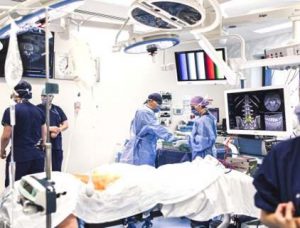“Advances in medical science are set to completely change health care. For example, genomic testing will help doctors diagnose health conditions and diseases earlier, as well as provide better prevention and treatment options for people. But these advances are very costly and come with some difficult ethical and legal issues that need to be worked through”
Australia, officially the commonwealth of Australia, is a sovereign country comprising the mainland of the Australian continent, the island of Tasmania, and numerous smaller islands. With an area of 7,617,930 square km, Australia is the largest country by area in Oceania and the world’s sixth-largest country.
Australia is the oldest, flattest, and driest inhabited continent, with the least fertile soils. It is a megadiverse country, and its size gives it a wide variety of landscapes and climates, with deserts in the center, tropical rainforests in the north- east, and mountain ranges in the south-east.
Australia is a highly developed country with a high-income economy; it has the world’s twelfth-largest economy, tenth-highest per capita income and eighth-highest Human Development Index. Australia is a regional power, and has the world’s thirteenth- highest military expenditure. The country ranks highly in quality of life, democracy, health, education, economic freedom, civil liberties, safety and political rights, with all its major cities faring exceptionally in global comparative livability surveys. It is a member of international groupings including the United Nations, the G20, the OECD, the WTO, ANZUS, AUKUS, Five Eyes, the Quad, APEC, the Pacific Islands Forum, the Pacific Community and the Commonwealth of Nations.
Healthcare in Australia
Australia’s health system is one of the best in the world, providing safe and affordable health care for all Australians. It is jointly run by all levels of Australian government – federal, state and territory, and local. It’s a key reason why we enjoy one of the longest life expectancies in the world.
There are many providers of health care in Australia, including: primary care services delivered by general practitioners (GPs), medical specialists, allied health workers and nurses.
Medicare and the public hospital system provide free or low-cost access for all Australians to most of these health care services. Private health insurance gives you choice outside the public system. For private health care both in and out of hospital, you contribute towards the cost of your health care.
 Medicare has been Australia’s universal health care scheme since 1984. Its 3 major parts are: medical services, public hospitals and medicines.
Medicare has been Australia’s universal health care scheme since 1984. Its 3 major parts are: medical services, public hospitals and medicines.
Medicare is available to Australian and New Zealand citizens, permanent residents in Australia, and people from countries with reciprocal agreements. Medicare covers all of the cost of public hospital services. It also covers some or all of the costs of other health services. These can include services provided by GPs and medical specialists. They can also include physiotherapy, community nurses and basic dental services for children.
The other important part of Medicare is the Pharmaceutical Benefits Scheme (PBS). The PBS makes some prescription medicines cheaper.
Health and technology
Advances in medical science are set to completely change health care. For example, genomic testing will help doctors diagnose health conditions and diseases earlier, as well as provide better prevention and treatment options for people. But these advances are very costly and come with some difficult ethical and legal issues that need to be worked through.
New technologies also have an impact on health and medical services — from digital health technologies to automated health and diagnostic services. These technologies help to improve the health system, but they can affect patients and the health workforce.
To meet some of these challenges, the Australian Government is investing in medical research and technological innovation through the Medical Research Future Fund. This will see more innovations developed, tested and made available for Australians in all areas of health care.
Comprehensive data can help us to improve health policy, programs and services. That’s why linking different health information across the health system is an important part of our work.
Australia shares other health system challenges with countries around the world — the rising cost of the health system, being able to respond to new health issues, inequality in access to health services and hospital waiting times.
 Medical devices market
Medical devices market
Approximately 80% of the medical devices used in Australia are imported and the domestic manufacturing industry is controlled by subsidiaries of large, global corporations. The Australia medical device market is mature, with a well-formed regulatory system and is one of the slowest-growing markets in the South Pacific region in coming years as market recovery was slow through out 2019 due to Australia’s depreciating currency. The market was valued at $4 billion in 2016, down from $5 billion in 2014. However, Australia’s aging population, Federal Budget initiatives, and willingness to adopt new technologies stabilized the market despite its modest growth.
Goldstein Market Intelligence analyst forecast the Australia medical device market size is growing at a CAGR of 10% through the forecast years (2017-2030). Intelligent medical equipment are officially endorsed by many hospitals and medical institutions, as well as by consumers themselves, are adding confidence to the Australia medical device market.
The medical technology (MedTech) industry is one of the most advanced and dynamic manufacturing sectors in Australia and has the potential to provide substantial health gains and highly skilled employment opportunities for Australians and add to Australia’s export industry.
There are 135 ASX-listed MedTech and pharmaceutical companies in Australia, with a market capitalization of $179 billion.
The MedTech industry in Australia is a substantial employer.
In 2014, it was estimated that the industry (including digital health) employs about 19,000 people.
It is also estimated that the total market for medical devices in Australia is valued at over $4.9 billion, with a compound annual growth rate of 1.4% since 2014. Despite representing a small market, Australia ranks as a prominent developer of MedTech worldwide. From the smallest sutures and neurosurgical coils to the largest linear accelerators, MedTech provides the platform from which healthcare is delivered. Without MedTech, healthcare cannot be delivered.
















